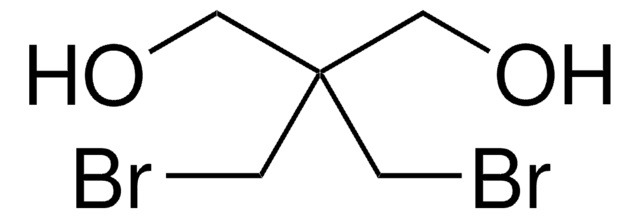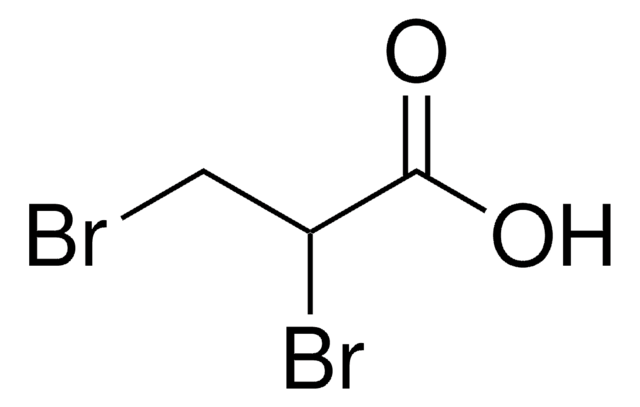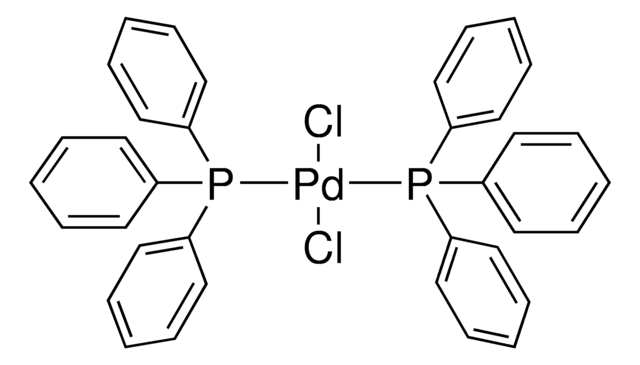All Photos(2)
About This Item
Linear Formula:
BrCH2CH(Br)CH2OH
CAS Number:
Molecular Weight:
217.89
Beilstein:
1719127
EC Number:
MDL number:
UNSPSC Code:
12352100
PubChem Substance ID:
NACRES:
NA.22
Recommended Products
Assay
98%
form
liquid
refractive index
n20/D 1.559 (lit.)
bp
95-97 °C/10 mmHg (lit.)
density
2.12 g/mL at 25 °C (lit.)
SMILES string
OCC(Br)CBr
InChI
1S/C3H6Br2O/c4-1-3(5)2-6/h3,6H,1-2H2
InChI key
QWVCIORZLNBIIC-UHFFFAOYSA-N
Looking for similar products? Visit Product Comparison Guide
Application
Synthetic building block, fire-proofing agent, and carcinogen.
Signal Word
Danger
Hazard Statements
Precautionary Statements
Hazard Classifications
Acute Tox. 3 Dermal - Acute Tox. 4 Inhalation - Acute Tox. 4 Oral - Aquatic Chronic 3 - Carc. 1B - Repr. 2
Storage Class Code
6.1A - Combustible acute toxic Cat. 1 and 2 / very toxic hazardous materials
WGK
WGK 3
Personal Protective Equipment
dust mask type N95 (US), Eyeshields, Gloves
Choose from one of the most recent versions:
Already Own This Product?
Find documentation for the products that you have recently purchased in the Document Library.
M D Gernon et al.
Chemistry and physics of lipids, 101(2), 215-222 (1999-10-26)
This work compares two reaction schemes for preparing 2,3-bis(fattyalkylthio)-1-propanols for further synthetic adaptation as hydrophobic analogs of lung surfactant phosphatidylcholines. An attempt to prepare 2,3-bis(fattyalkylthio)-1-propanols based on the previously published methods of Bell and co-workers (B.R. Ganong, C.R. Loomis, Y.A.
2,3-Dibromo-1-propanol.
Report on carcinogens : carcinogen profiles, 11, III84-III84 (2004-01-01)
R Benigni
Mutagenesis, 6(5), 423-425 (1991-09-01)
A QSAR model based on the combination of two molecular descriptors--estimated electrophilic reactivity and Ashby's structural alerts--was used to predict the carcinogenicity of 44 chemicals currently bioassayed by the US National Toxicology Program. These predictions will be compared with the
S L Eustis et al.
Fundamental and applied toxicology : official journal of the Society of Toxicology, 26(1), 41-50 (1995-06-01)
2,3-Dibromo-1-propanol is a metabolite of the flame retardant tris(2,3-dibromopropyl) phosphate, previously shown to be a mutagen and carcinogen in experimental animals. Toxicology and carcinogenesis studies of 2,3-dibromo-1-propanol were conducted by applying the chemical in 95% ethanol to the interscapular skin
2,3-Dibromo-1-propanol.
Report on carcinogens : carcinogen profiles, 10, 82-83 (2004-08-25)
Our team of scientists has experience in all areas of research including Life Science, Material Science, Chemical Synthesis, Chromatography, Analytical and many others.
Contact Technical Service










